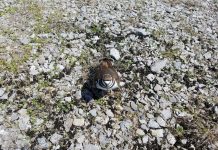BY SARA CLIFFORD
For The Republic
BELMONT—The out-of-town guests shifted and swatted even under the shade of the tent.
It was 90-plus degrees still at 5 p.m., and the insects were doing their work on the adjacent flower garden.
Selma Steele could have related.
When she moved to that very piece of land from Indianapolis 109 years ago with her new husband, painter T.C. Steele, the environment took a lot of getting used to.
Getting a garden to take root on the steep hillsides was no easy task. She lost an entire season of bulbs to washouts, art historian Rachel Perry said.
But she read, she researched, she retried. She trucked in soil; she brought in trees; she babied tiny seeds until they could survive and thrive.
It took years, but Selma sculpted from the Brown County clay an ever-changing palette of flowers: peonies, irises, columbine, foxglove, bleeding hearts, lilies, wisteria and daffodils among the wild landscape, Perry said.
T.C. Steele became a leader in the spread of impressionist landscaping painting throughout the Midwest. He was the one who became famous.
But Selma’s work also deserves recognition, Perry told the crowd under the tent, fanning themselves with prints of the painting “Selma in the Garden.”
“Selma has often been maligned for her supposed task-mastering of the painter, allegedly forcing him to waste no time and producing landscapes for sale,” Perry said.
“Nothing could be further from the truth.”
Selma’s toils, creating a sanctuary of ponds, paths and color, “made it possible for T.C. Steele to wander off at daybreak and follow his muse — something that his passion and training made crucial for his emotional well-being,” Perry said.
The crowd gathered at Selma’s formal gardens July 22 included some of the people responsible for restoring the first of nine gardens on the Steele property, which is now a state historic site.
The formal gardens had been gradually buried under 6 inches or more of soil, said Site Manager Andrea deTarnowsky.
Historic site volunteers and staff spent hundreds of hours walking the area with metal probes trying to find the walkways Selma had placed, and poring over Selma’s collection of gardening books and journals to determine what she had planted and where.
They even studied T.C. Steele’s paintings for clues and historical photographs with magnifying glasses trying to identify the foliage, deTarnowsky said.
The result is “partly a restoration and partly an adaptation,” she said. “We really struggled to remain true to Mrs. Steele’s vision, but we also knew we needed to adapt certain features to accommodate modern safety and access needs.”
Gary and Kathy Anderson of Nashville funded the work at the formal gardens. That’s where they had their first date in May 1974. He is now a board member of the Indiana State Museum and she sits on state and local arts boards.
There’s nothing like the Steele property in all of Indiana or in all the country; the closest thing to it is in France, Gary Anderson said.
“The artist colony of plein air that grew up here is still here,” he said. “This is a national treasure.”
Six of the planned nine restoration projects are funded. The formal gardens are the first project in phase one, which also includes lily ponds and winding paths.
Two other phases are planned to revive the flower gardens around the Steeles’ House of the Singing Winds, as well as rock gardens, an orchard and trellises.
Selma was schooled in painting herself, but she never painted again after she married Steele. “I wanted to realize my conception of the beauty I discovered about me, even if it was to be imaged in other forms than his,” Perry quoted Selma as saying.
Without Selma’s devotion to the art of gardening, the painter “likely wouldn’t have been as prolific or contentive for his efforts to labor on canvas the quiet beauty of Brown County,” Perry said. “Selma’s unilaterally successful efforts to make the House of the Singing Winds a public sanctuary helped memorialize her artist husband in perpetuity.”
Brandt Nicholson Steele, a retired professor of classics, came from Greencastle for the ceremony to remember T.C. Steele, his great-great-grandfather.
He said he didn’t inherit any of Steele’s artistic talent, but he remembered visiting the studio as a teen, when a dirt road led to it.
Though the new plantings won’t be in their full glory for about two years, Brandt Steele was all smiles about the progress at the site, posing for a picture under the arbor.
“This really is a transformation,” he said.
More people need to know about the significance of the site and experience its quiet beauty, Gary Anderson said.
“Hopefully, 100 years from now, it will receive far greater recognition outside our boundaries.”
[sc name=”pullout-title” pullout-title=”T.C. Steele State Historic Site” ]
[sc name=”pullout-text-begin” ]
Where: 4220 T.C. Steele Road, west of Nashville near Belmont
Contact: 812-988-2785, [email protected]
Web: tcsteele.org
Hours: Open year-round Tuesdays to Saturdays, 9 a.m. to 5 p.m.; Sundays, 1 to 5 p.m.; closed Mondays except Labor Day; open on Memorial Day and Independence Day.
What: 211 acres of gardens, grounds and hiking trails may be enjoyed at no cost; the House of the Singing Winds and Steele’s Large Studio, including exhibits of his paintings, may be toured for a fee. The Selma Steele Nature Preserve includes trails through 92 acres of woods, wildflowers, ravines, streams and wildlife.[sc name=”pullout-text-end” ]




